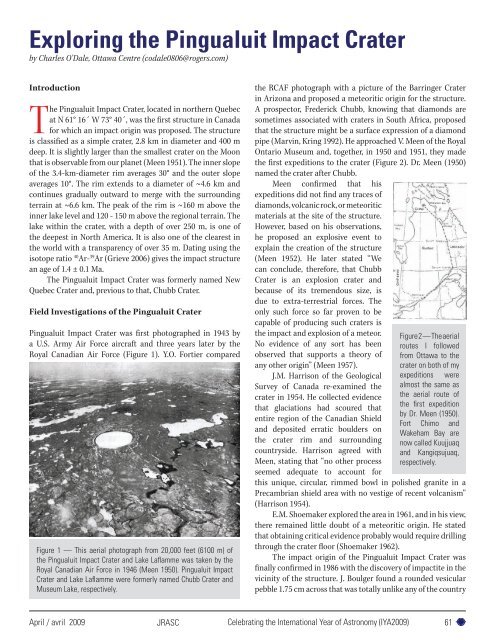Moment
insidethisissue - The Royal Astronomical Society of Canada
insidethisissue - The Royal Astronomical Society of Canada
You also want an ePaper? Increase the reach of your titles
YUMPU automatically turns print PDFs into web optimized ePapers that Google loves.
Exploring the Pingualuit Impact Craterby Charles O’Dale, Ottawa Centre (codale0806@rogers.com)IntroductionThe Pingualuit Impact Crater, located in northern Quebecat N 61° 16´ W 73° 40´, was the first structure in Canadafor which an impact origin was proposed. The structureis classified as a simple crater, 2.8 km in diameter and 400 mdeep. It is slightly larger than the smallest crater on the Moonthat is observable from our planet (Meen 1951). The inner slopeof the 3.4-km-diameter rim averages 30° and the outer slopeaverages 10°. The rim extends to a diameter of ~4.6 km andcontinues gradually outward to merge with the surroundingterrain at ~6.6 km. The peak of the rim is ~160 m above theinner lake level and 120 - 150 m above the regional terrain. Thelake within the crater, with a depth of over 250 m, is one ofthe deepest in North America. It is also one of the clearest inthe world with a transparency of over 35 m. Dating using theisotope ratio 40 Ar- 39 Ar (Grieve 2006) gives the impact structurean age of 1.4 ± 0.1 Ma.The Pingualuit Impact Crater was formerly named NewQuebec Crater and, previous to that, Chubb Crater.Field Investigations of the Pingualuit CraterPingualuit Impact Crater was first photographed in 1943 bya U.S. Army Air Force aircraft and three years later by theRoyal Canadian Air Force (Figure 1). Y.O. Fortier comparedFigure 1 — This aerial photograph from 20,000 feet (6100 m) ofthe Pingualuit Impact Crater and Lake Laflamme was taken by theRoyal Canadian Air Force in 1946 (Meen 1950). Pingualuit ImpactCrater and Lake Laflamme were formerly named Chubb Crater andMuseum Lake, respectively.the RCAF photograph with a picture of the Barringer Craterin Arizona and proposed a meteoritic origin for the structure.A prospector, Frederick Chubb, knowing that diamonds aresometimes associated with craters in South Africa, proposedthat the structure might be a surface expression of a diamondpipe (Marvin, Kring 1992). He approached V. Meen of the RoyalOntario Museum and, together, in 1950 and 1951, they madethe first expeditions to the crater (Figure 2). Dr. Meen (1950)named the crater after Chubb.Meen confirmed that hisexpeditions did not find any traces ofdiamonds, volcanic rock, or meteoriticmaterials at the site of the structure.However, based on his observations,he proposed an explosive event toexplain the creation of the structure(Meen 1952). He later stated “Wecan conclude, therefore, that ChubbCrater is an explosion crater andbecause of its tremendous size, isdue to extra-terrestrial forces. Theonly such force so far proven to becapable of producing such craters isthe impact and explosion of a meteor.No evidence of any sort has beenobserved that supports a theory ofany other origin” (Meen 1957).J.M. Harrison of the GeologicalSurvey of Canada re-examined thecrater in 1954. He collected evidencethat glaciations had scoured thatentire region of the Canadian Shieldand deposited erratic boulders onthe crater rim and surroundingcountryside. Harrison agreed withMeen, stating that “no other processseemed adequate to account forFigure 2 — The aerialroutes I followedfrom Ottawa to thecrater on both of myexpeditions werealmost the same asthe aerial route ofthe first expeditionby Dr. Meen (1950).Fort Chimo andWakeham Bay arenow called Kuujjuaqand Kangiqsujuaq,respectively.this unique, circular, rimmed bowl in polished granite in aPrecambrian shield area with no vestige of recent volcanism”(Harrison 1954).E.M. Shoemaker explored the area in 1961, and in his view,there remained little doubt of a meteoritic origin. He statedthat obtaining critical evidence probably would require drillingthrough the crater floor (Shoemaker 1962).The impact origin of the Pingualuit Impact Crater wasfinally confirmed in 1986 with the discovery of impactite in thevicinity of the structure. J. Boulger found a rounded vesicularpebble 1.75 cm across that was totally unlike any of the countryApril / avril 2009JRASCCelebrating the International Year of Astronomy (IYA2009)61
















